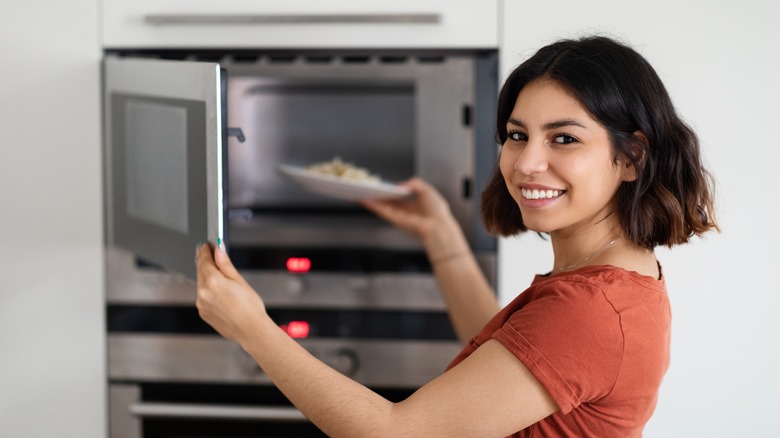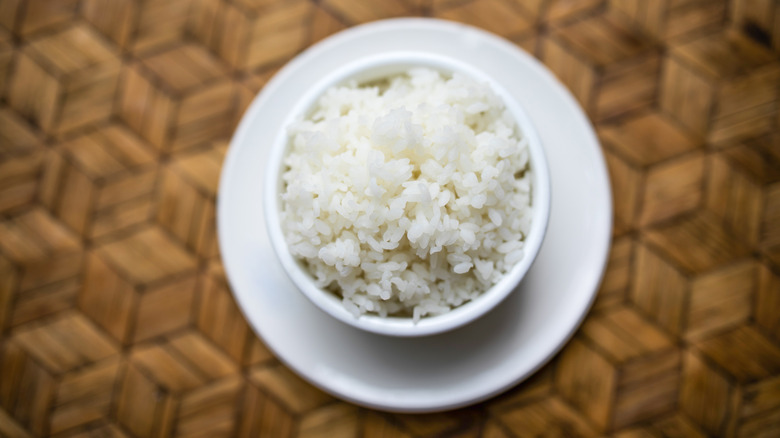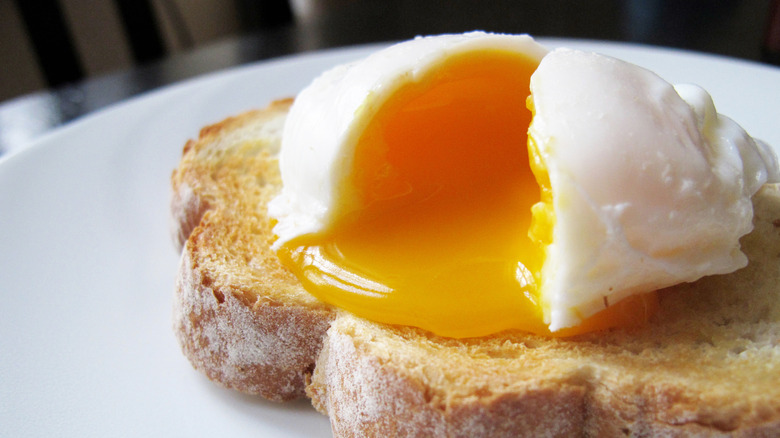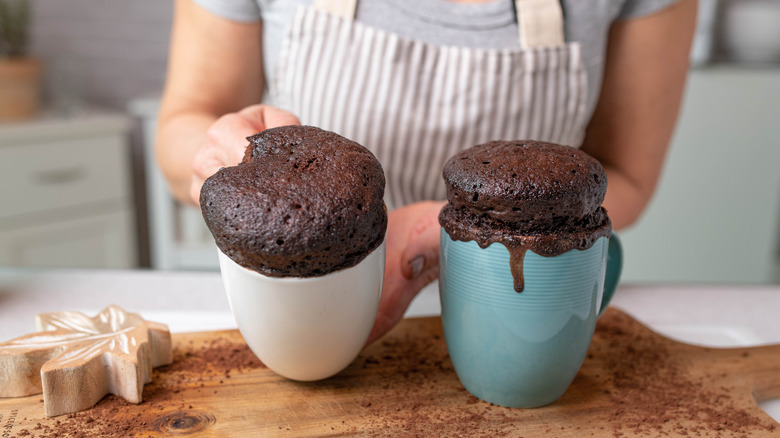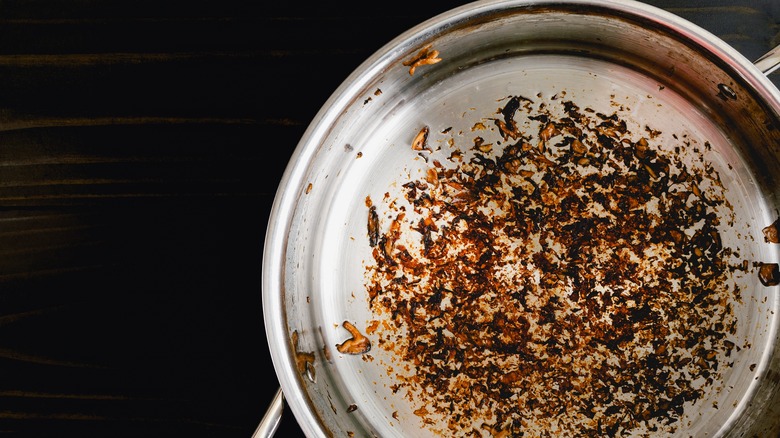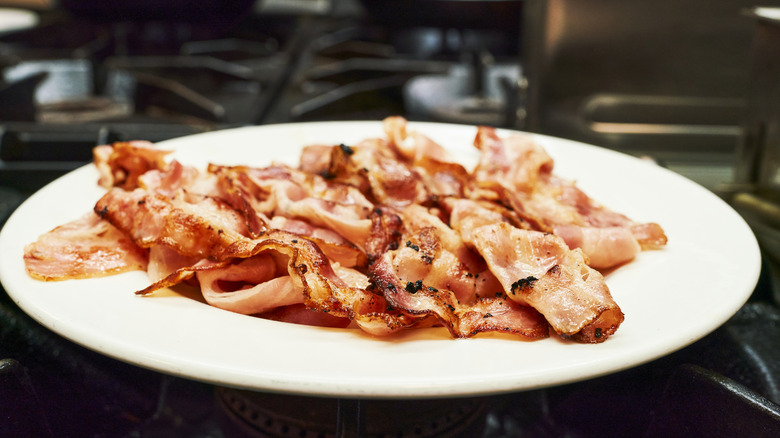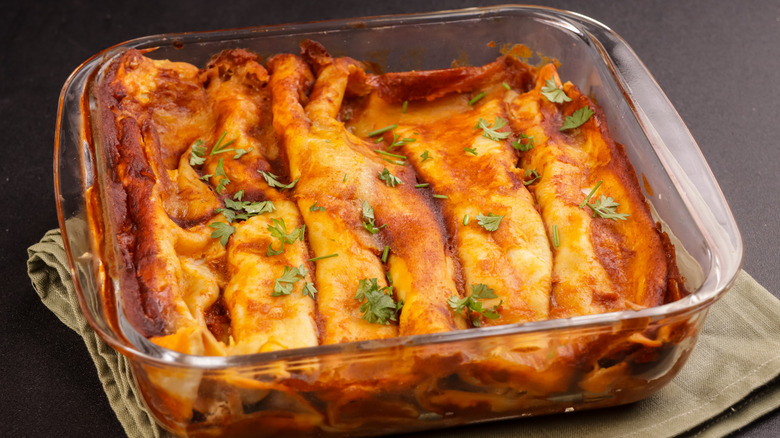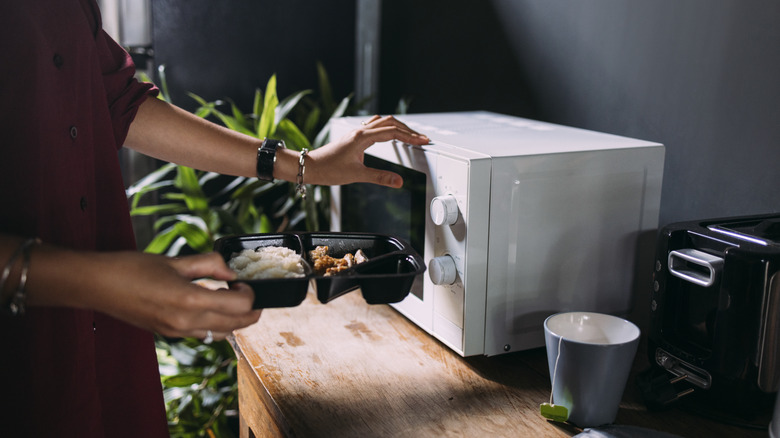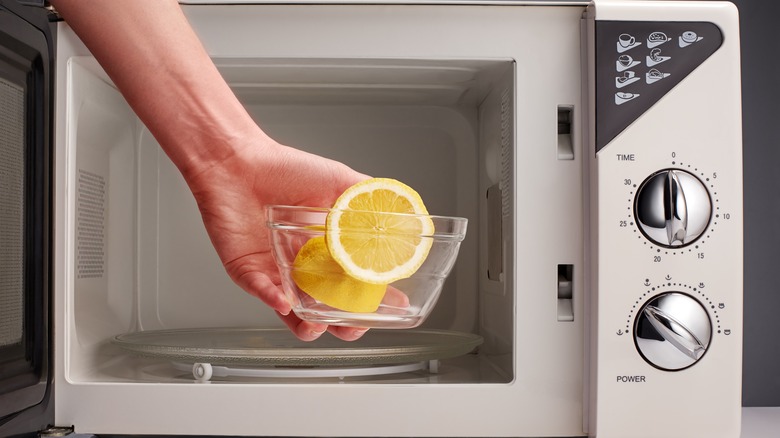10 Tips For Better Microwave Cooking
Most of us have one in our kitchens, but it's likely that we're not getting the best use out of our microwaves. These appliances can do a lot more than reheat yesterday's dinner. So, how can we unlock the potential of the microwave? What are some microwave tips and tricks that make your life easier?
We reached out to Aldana Iturri, Test Kitchen Lead at Anyday, who specializes in easy, safe, microwave cooking. She filled us in on some of her best practices and favorite hacks when working with the microwave. We also spoke to James Beard Award-winning Chef Frank Bonanno, the mastermind behind Bonanno Concepts and a small empire of restaurants across Denver, to see what a top chef has to say about using the microwave. Unsurprisingly, he won't go there in a professional kitchen, but Chef Bonanno admits it can be a handy tool for the home chef running short on time and shared his favorite microwave uses.
Check the power setting
Aldana Iturri says the key to good microwave cooking is mastering your microwave's power settings. Many of us never think to check them! "Most microwaves default to full power," Iturri explains, "but adjusting the level can significantly improve your cooking results." Take a look at all those buttons on your microwave, and if you still have the user manual kicking around in a drawer somewhere, pull it out and make sense of the many settings. It's worth knowing what this thing can actually do. At the very least, get familiar with the microwave's power level button.
Iturri says you can think of your microwave almost like a stovetop burner, where the full power setting is like cooking with high heat, and the lower levels are more gentle. She says that high power is "ideal for boiling liquids or steaming vegetables quickly." Meanwhile, the lower settings can cook things like custards and grains evenly, or even more delicate proteins like eggs and fish. Many of us wouldn't dare cook fish in the microwave, but Iturri says it's totally possible if you've got it on the right settings. "Using different power settings helps prevent overheating and rubbery or dry food," advises Iturri, "and ensures your dishes come out perfectly cooked every time."
Add a splash of water
If you're looking to quickly add some veggies to your weeknight meal but you don't want to clean a second set of pots and pans, the microwave can produce tasty steamed vegetables in no time. The trick to cooking them this way, says Chef Frank Bonanno, is to add a tablespoon of water to a bowl with vegetables. Then cover the bowl with a microwave-safe plate (never wrap it in plastic). You need to keep the moisture in to effectively steam the vegetables. "Three minutes and you have fantastic steamed vegetables that have retained their nutrients," says Chef Bonanno. How simple is that?
A splash of water can help revive other leftovers, too. Keeping some extra moisture in the mix will stop things from drying out. Sprinkle just a little water over pasta or rice before reheating it in the microwave.
Let reheated rice rest
Day-old rice will be hard when it comes out of the refrigerator. When you reheat it in the microwave, you're aiming for evenly cooked, soft, fluffy rice, and Chef Frank Bonanno says the way to achieve that is to let it rest before pulling it back out of the microwave. "Keep it covered and undisturbed for five minutes after the microwave turns off," Chef Bonanno directs. "This resting time is a must if you want the rice to cook evenly."
When it comes to rice, you can also cook it from scratch in the microwave. Now, it doesn't necessarily save you much time, but some would argue it still eliminates some extra mess, burnt bits at the bottom of a pot, and might even produce better results when done right. Some recipes call for microwaving in two stages, first uncovered, then covered. You'll need to cover the bowl of rice with a microwave-safe lid or towel to keep the steam in.
Poaching eggs just got a lot easier
There are many ways to cook eggs in the microwave, but what excites us most is a simple, foolproof way to make poached eggs. That's right, the fancy brunch egg is achievable in seconds when you use your microwave. Poaching is a wonderful, healthy method of cooking that limits added fats and oils. Beyond that, poached eggs have a unique texture and a place of pride in the brunch lineup. If eggs Benedict or eggs Norwegian make your mouth water, but you never thought you could pull it off at home, think again.
This YouTube video went viral when a chef showed us how simple it can be to poach a perfect egg in the microwave. Just place it in a glass with an inch (or so) of water and microwave for 35-50 seconds.
Baking doesn't have to happen in the oven
Aldana Iturri spent nearly two decades working in kitchens as a sous chef before transitioning to her role as a recipe tester. She reminds us that you can use the microwave to do more than just reheat leftovers and zap ready-made meals. Cooking from scratch (and even baking) can happen in the microwave. She and her team have developed over 400 recipes – from chicken casserole to fudge brownies and blondies — that showcase just how easy cooking from scratch in the microwave can be. Anyone who has a small kitchen, a limited amount of time, or a desire to keep things extra simple should try microwave cooking.
Have you seen those viral cakes in a mug? If you're craving dessert but you don't need a whole big sheet cake or fancy a mountain of dishes to clean up, the microwave is the perfect tool for single-serving bakes. You can even give microwave mug cakes a savory pizza twist!
Toast nuts without burning them
Frank Bonanno and Aldana Iturri both mentioned using the microwave to toast nuts. Many recipes will call for a sprinkle of toasted nuts, and making them in the oven or on the stovetop can be one of those fussy preparations that often ends up going wrong. Leave them a second too long and you end up with burnt almond slivers or pine nuts, costing you time and valuable (expensive) ingredients. So, when you're already doing a million other things in the kitchen, why not make your life a little bit easier and toast those nuts in the microwave?
Whether you're topping a cake, adorning a salad, or adding some crunch to a pasta, toasted nuts can seriously elevate a dish. So, how do you get them perfectly toasted in the microwave? "One layer on a plate, 30-second increments," says Chef Bonanno, "and you have perfectly, evenly toasted nuts without heating your entire oven." There you have it: Your microwave might be the secret to perfectly roasted nuts.
Brown butter without burning it
Steps like browning butter can also happen in the microwave, saving time and mess on the stovetop. Lots of recipes call for browned butter to add a nutty flavor to baked goods, but it's yet another step that can easily go wrong — from perfect nutty brown to a burnt, buttery mess in seconds. So, instead of hovering over the pan worrying about how to tell when brown butter is done cooking, let the microwave do it for you and take out some of the stress and guesswork.
Browned butter can be a seriously sophisticated upgrade to many recipes, not just baked goods. You can make brown butter mashed potatoes and even browned butter cocktails. But just because the results are elevated, doesn't mean the process of getting there should be difficult. Aldana Iturri says the microwave will do the trick, no fuss, no muss.
Crisp bacon with minimal splatter
Cooking bacon is yet another process that tends to go awry when we aren't paying attention. This increasingly expensive beloved breakfast food is truly a shame to waste, but it can go from crisp perfection to blackened travesty the second we take our eye off the prize. If the pan has uneven heat distribution, you could also end up with bacon strips that are overcooked in the center and still rubbery at the edges. Not to mention the scalding hot grease that notoriously jumps out of the pan and onto unsuspecting bare forearms of cooks everywhere.
Okay, so we're being a little dramatic. But seriously, it can be a drag trying to cook perfect bacon, especially when your focus is elsewhere. Many opt to make bacon in the oven, but the microwave is another surprisingly easy option that can get the job done much faster. If you're intrigued, you can skip the preheat time and the hot grease and easily learn how to cook crispy bacon in the microwave.
Prepare tortillas for any recipe
If you love tacos, you'll know that no great taco is prepared on a cold tortilla. But when you're feeding a crowd, do you have time to toast each tortilla individually on a hot pan? That sounds lovely, but it takes forever. The oven can handle more tortillas at once, but then you have to wait for it to preheat, and be sure to pull them out before they get so tough you can hardly bite through them. So if soft, pliable tortillas are what you're after, why not let the microwave handle this task? You can use the microwave to heat tortillas, several at a time, until they're warm and easy to handle.
If you want to make enchiladas, and you need your tortillas to be pliable enough to roll without cracking, the microwave can help here, too. Corn tortillas can be quite brittle straight out of the package, and trying to roll fillings in them will yield a shattered, crumbly result. But if you wrap a stack of corn tortillas in some damp paper towels and zap them for a minute or two, they'll be nice and soft and pliable. Just don't cook them too long, or with too much water, or they might start to get mushy.
Avoid microwaving plastic
Most of us are used to tossing Tupperware in the microwave, but Aldana Iturri advises that we don't use plastic in the microwave at all if we can help it. Zapping leftovers in a plastic container can "leach unwanted microplastics and chemicals into your food," Iturri says. Microplastics are a scary buzzword at the moment, and nobody wants to increase their levels if they can help it. So don't put your ancient plastic containers into the microwave. "Instead," Iturri says, "opt for microwave-safe glass containers (like Anyday's dishes) with microwave-safe vented glass lids that promote even heating and keep food tender and moist."
And it should go without saying that you also can't put metal in the microwave. If you've ever tried it and observed the ensuing bolts, you'll know why. Metal actually deflects the microwaves meant to heat the water content of your food, and sends them bouncing around in a way that can even become dangerous, causing sparking and even fires. That's why you won't reheat anything in tin foil in the microwave, though you can use tin foil in the air fryer.
Basically, there's a reason why certain dishes and containers are marked "microwave safe," and you really should not use any that aren't. Iturri reiterates, "Regular plastic lids, or other non-microwave-safe lids (such as bamboo) can warp when heated or release toxins." Nobody wants misshapen dishware or contaminated food. Just invest in a little cookware that's designed for microwave cooking. There are loads on the market today. It can cost more, but it's worth the investment. You can even buy Anyday cookware on Amazon.
Clean regularly without harsh chemicals
If you're wondering how and how often you need to clean your microwave, we have answers from the experts, and the good news is it's pretty simple. Aldana Iturri and Frank Bonanno agree, you don't need to bust out the bleach and the Lysol to get the microwave clean. Kitchen staples like vinegar, baking soda, and lemon can do the trick. And wouldn't we all prefer less harsh chemicals around our food? The key is just to clean it a little more often so you don't end up in dire situations that require heavier products.
Bonanno says that a small bowl of water and lemon juice can work wonders on a lightly soiled microwave. Set the microwave to high, run it for 5 minutes, and then wipe down the inside walls and tray while it's still steamy. "Works better than any chemical cleaner I have tried," assures Bonanno. Iturri agrees this steaming method is the best way to get off tough grime. She adds equal parts water and vinegar, or water and lemon juice, to help cut grease.
When a bit of a deeper clean is required to remove tougher stains or stuck-on food, Iturri says, "Make a paste of baking soda and water, apply it to the stain or food, let it sit for five minutes, and then wipe clean." Baking soda can also come in handy if any unwanted smells are lingering in the microwave, she says. Just like with the lemon, add some baking soda to a bowl of water and microwave it uncovered. But this time, she says, let it sit in the microwave for a further 5-10 minutes before opening it up and wiping it down. That gives the baking soda a little more time to go to work.
